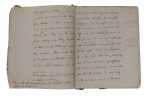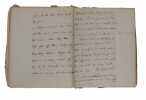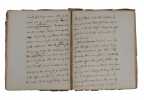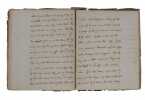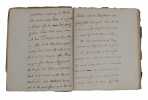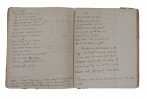"EGIL’S SAGA - NIELS MATTHIAS PETERSEN (transl.).
Egil’s Saga or A Tale about Egil Skallegrimson after the Icelandic original Text (original handwritten manuscript). - [EARLY MANUSCRIPT-TRANSLATION OF EGIL'S SAGA BY RENOWNED DANISH PHILOLOGIST N. M. PETERSEN]
(Manuscript, posssibly 1835-1839, no later than 1862). 4to (225 x 177 mm). In four parts, all in contemporary blank grey stitched paper wrappers. Tome-numbers to front wrappers. In fine legible handwriting. Vol. 1. with numerous corrections in pencil throughout in different hand than the translation. Front wrapper On vol. 1 detached and missing paper in margins. Otherwise fine. 347 ff. with text on both verso and recto.
Reference : 60374
Original unpublished manuscript translation of ""Egil's Saga"" into English, done in the mid-19th century by renowned Danish philologist Niels Matthias Petersen, first professor of the Nordic languages in Denmark, predating the first published English translation with circa 50 years. Egil's saga is generally considered amongst the best and most beloved of the Icelandic sagas. Based on Petersen’s industriousness and diligent work in having his research and translations published and the many third party textual and grammatical corrections throughout the text, the present translation was most likely intended for publication. It is not evident exactly when the translation was made nor it is clear from which text/manuscript it is translated. Petersen spent time on a Danish translation of Egil’ saga in the period 1835-1839 and it is likely that the present English translation also was made then. For Petersen’s Danish translation (In the Four volume-work: “Historiske Fortællinger om Islændernes Færd”, 1839-1844) he used the second printed edition of Egil's saga from 1809. It was produced for the Arnamagnæan Commission by Gudmundur Magnússon. It has a short introduction in Latin, followed by the text of the saga and a parallel translation in Latin. This text is in the main based on that of Codex Mödruvallensis (Ms. No. 132. Fol.) in the Arnamagaean Collection. It is highly likely that Petersen also used the 1809-edition for this present English translation. The saga spans the years c. 850-1000. Its oldest manuscript (a fragment) dates back to 1240 AD, and comprises the sole source of information on the exploits of Egill, whose life is not historically recorded. Stylistic and other similarities between Egill's Saga and Heimskringla have led many scholars to believe that they were the work of the same author, Snorri Sturlasson. Not until 1893 was an English translation published. It was translated by W. C. Green from the original Icelandic “Egils saga Skallagrímssonar”. Eddison, author of epic fantasy novels and occasional member of the Inklings, judged it as ""being so bad as to be unreadable"". Eddison thought that the saga ‘perhaps the finest of all except Njal’ deserved better, and that Egil Skallagrimson, the ‘most typical of the true viking spirit’, should be brought to a wider audience – consequently Eddition made his own translation in 1930. The syntax and vocabulary in this translation are deliberately archaic in order to maintain the style of the Icelandic. Three later English translations were made: Gwyn Jones (1960), Christine Fell (1975) and Hermann Pálsson and Paul Edwards (1976). The most recent English translation is in The Complete Sagas of Icelanders (1997). Niels Matthias Petersen (1791-1862), linguist, philologist, historian and literary historian, is regarded as being the father of modern Danish saga-studies. During his school years he befriended Rasmus Rask, his senior by four years, who kindled his interest in Old Norse and the ancient history of the Nordic countries. During his theological studies, which did not lead to a formal graduation, he pursued these interests. After working as a teacher in a seminary near Odense in the period 1815-26, he returned to Copenhagen, where he remained for the rest of his life. His first linguistic publications appeared in 1826.In 1829, Petersen entered the employment of the University Library, then of the Danish central archive. In these years he published a major language history (1829-30), a work on Denmark's early history (1834-37) and a translation and edition of a large portion of the Icelandic sagas (1839-44). ""He was the first to publish a substantial collection of Icelandic sagas in translation, ten sagas in four volumes under the title ""Historical accounts of the dealings of the Icelanders at home and abroad"" (Historiske Fortællinger om Islændernes Færd hjemme og ude, 1839-44). Petersen's aim was to present the sagas as enjoyable reading for the general public, and to strengthen the Danish language by introducing Old Norse-Icelandic neologisms.In 1845 Petersen was appointed to the first professorship in the Scandinavian languages in the Nordic countries, a position he kept to his death in 1862. In this period he wrote the modestly-titled, but comprehensive and groundbreaking five-volume ""Contribution to the history of Danish literature"" (Bidrag til den danske Literaturs Historie, 1853-61). In this work Petersen introduces into Danish the theory of periodization, and several of his period titles have survived in later accounts. His concept of literature was not restricted to imaginative writing but encompassed the entire body of writings valued in society. For Petersen, literature not only documents and reflects the nation's culture, but also exercises a formative influence on it."" (Encyclopedia of Romantic Nationalism in Europe). For various publications by Petersen including translations of Egil's Saga see: Klose 4870-4894.Fiske pp. 460-461.
Bookseller's contact details
Herman H. J. Lynge & Son
William Schneider
Silkegade 11
1113 Copenhagen
Denmark
+45 33 155 335
Payment mode
Sale conditions
All items may be returned for a full refund for any reason within 14 days of receipt.
 Write to the booksellers
Write to the booksellers

